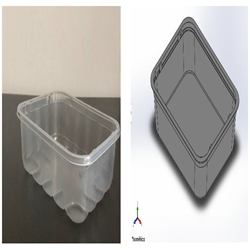The development of microwave absorbing materials (MAMs) has been driven by the need to exploit electromagnetic (EM) waves for wireless telecommunication systems and reduction of radar signatures. MAMs are required to have a large electric and magnetic loss in the frequency range of interest. Ferrites with hexagonal structure are anisotropic and have a large intrinsic magnetocrystalline anisotropy field. Hexaferrites have been used for applications above 3 GHz due to their increased ferromagnetic resonance. In this work, MnZn doped Sr-U hexaferrites were synthesized using high energy ball milling (HEBM) and sintering at 1100°C. The magnetic, dielectric, and electromagnetic wave absorbing properties of the composites were measured in the frequency range of 8–18 GHz.
Starting materials for the preparation of strontium manganese zinc hexaferrite were weighed according to the desired compositions and mixed using a ball mill for homogeneity. The powder mixtures were further milled using a high energy ball mill (HEBM) in a hardened steel vial together with grinding balls. The milling time and the ball to powder weight ratio (BPR) ratio were used to obtain nanoparticles as the starting powder. The obtained powder was then sintered at 1100°C. The phase, microstructure, and magnetic properties of the composites were characterized by XRD and FESEM. The complex permittivity, permeability, and reflection loss (RL) of the composites were measured using a Vector Network Analyzer in the frequency range of 8–18 GHz.
XRD patterns showed that all the composites were single-phase U-type hexaferrite with rhombohedral crystal structure. FESEM images revealed that the particles were agglomerated with a particle size range of 100-200 nm. The magnetic properties of the composites were measured using Vibrating Sample Magnetometer (VSM) and the results showed that the saturation magnetization decreased with increasing MnZn doping. The natural resonance of the composites was shifted to lower frequencies with increasing MnZn doping. This can be attributed to the reduction in magnetocrystalline anisotropy due to the introduction of MnZn ions in the lattice. The decrease in saturation magnetization with increasing MnZn doping could be attributed to the reduction of magnetic moments in the hexaferrite lattice, which could be caused by the smaller ionic radius of Mn2+ and Zn2+ ions as compared to Fe3+ ions.
The complex permittivity and permeability were determined using the measured S-parameters from the VNA. The real part of the complex permittivity (ε') and permeability (μ') of the composites decreased with increasing frequency, whereas the imaginary part (ε'' and μ'') increased with increasing frequency. The minimum reflection loss (RL) was observed at 14.00 GHz and 15.60 GHz for all thicknesses, which was due to the natural resonance of the materials. The composite with MnZn doping of 0.8 showed the highest RL value for all thicknesses of 1 mm, with two peaks at approximately −32.50 and −41.50 dB at 14.00 and 15.60 GHz, respectively, with a bandwidth of 0.60 and 0.80 GHz for losses less than −10 dB.
The microwave absorbing properties of the composite are primarily attributed to the natural resonance of the materials, which is influenced by the magnetocrystalline anisotropy of the hexaferrite. The increase in MnZn doping shifted the natural resonance of the materials MnZn doped Sr-U hexaferrites with tuned magnetic and microwave absorbing properties could have potential applications in the field of microwave technology, such as in electromagnetic interference (EMI) shielding, stealth technology, microwave absorption, and other related fields.
The results of this study indicate that the MnZn doping of Sr-U hexaferrites could be a promising strategy for achieving tunable magnetic and microwave absorbing properties. The use of HEBM to prepare nanoparticles as the starting material and sintering at high temperature can result in a single-phase U-type hexaferrite with improved magnetic and microwave absorbing properties.
Future work can focus on exploring other doping elements and optimizing the sintering conditions to further improve the magnetic and microwave absorbing properties of the composite. Moreover, the composite could be tested for its durability, thermal stability, and other properties to assess its suitability for practical applications.
In conclusion, this work provides a novel approach to synthesize MnZn doped Sr-U hexaferrites with improved magnetic and microwave absorbing properties. The results of this study could have significant implications for the development of advanced materials for microwave technology applications.
By
Dr Ismayadi Ismail
ION2, UPM
Original article can be downloaded from here:
https://www.sciencedirect.com/science/article/pii/S0925838821046569?via%3Dihub
https://doi.org/10.1016/j.jallcom.2021.163246
Date of Input: 27/06/2023 | Updated: 10/08/2023 | roslina_ar
MEDIA SHARING























